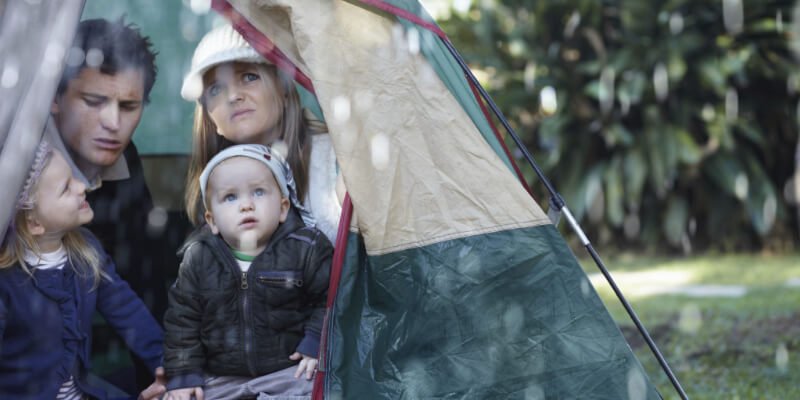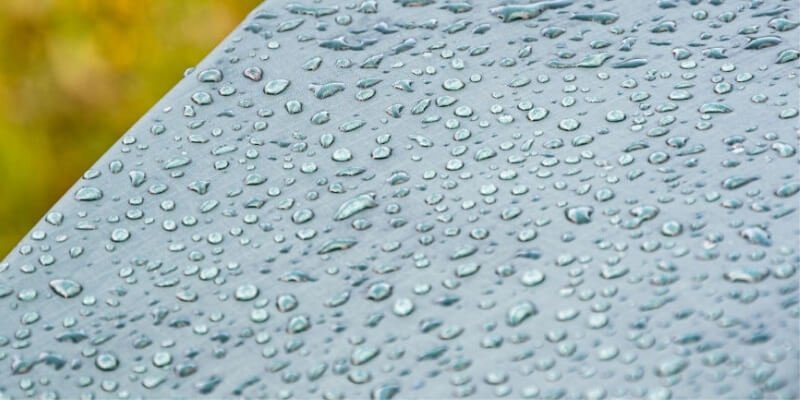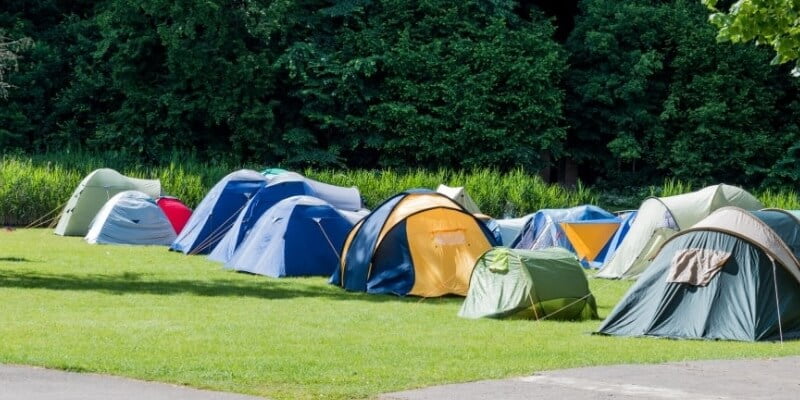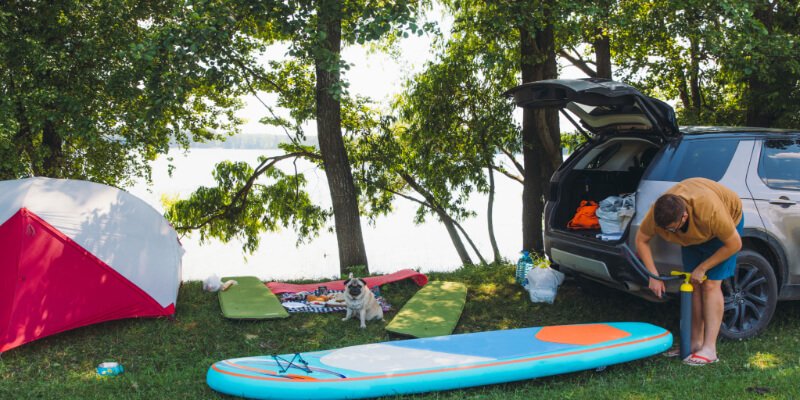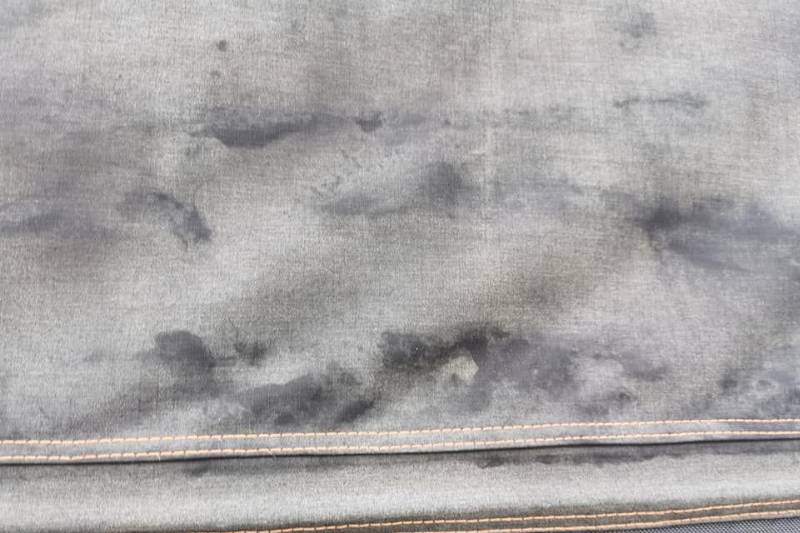32 Tent Care Tips – Make Your Tent Last Longer

Whether you’re a passionate camper or a casual adventurer, your tent is your sanctuary in the wilderness. Those who take good care of their tent can enjoy their mobile accommodation for a long time. So if you want to enjoy your tent for many years to come, you should make maintenance a habit.
Fortunately, we have collected 32 awesome tent care tips so that you don’t suddenly get woken up by a cold gush of water in your face on a rainy night. From routine cleaning routines to preventative measures against wear and tear, these strategies will help you get the most out of your outdoor investment.
Why Do I Take Care of My Tent and Maintain It Regularly?
Camping with a good tent is very relaxing. It is incredibly satisfying to pitch your tent in a beautiful spot on the campsite and fall asleep in the trouble-free sounds of nature.
Your tent will keep you dry while it is raining. It protects you from wind and cold. The feeling of opening the door after a restful night and breathing the fresh morning air is an incomparable pleasure.
If you know how to properly take care of your tent, your love will return. A well-maintained tent is completely waterproof and reliably protects you from the elements. Also, a well-maintained tent lasts twice as long on average. With our care tips, you will save money because you no longer have to constantly buy new tents.
Tent Maintenance Tips Before the Tour
The maintenance of your tent ideally starts at home before the tour. The advantage is you can eliminate the weak points of the tent before you expose it to wind and rain. And you make sure you have everything you need. After the check-up, your tent can withstand longer transport without any problems and is easy to set up.
1. Do a home test setup
As I mentioned above, before you start your camping tour, do a test setup at home in peace and without pressure. Make sure you have all the pegs, tent poles, and accessories you will need. Check to see if your tent needs repair. Repair broken tent poles and use a garden hose to test whether the tent is still waterproof. If necessary, mend cracks and holes with your repair kit.
You treat leaky seams with a seam sealer. This is mostly only necessary for tents with a silicone coating because they cannot be sealed with seam tape.
2. Take good tent pegs with you
We met the hardest ground on which we have camped so far on the beach of the North Sea. Hidden under a thin layer of sand was the mud of the Wadden Sea, from which the sun had baked a rock-hard barrier. Because you often don’t know what ground you’re hitting, bring different types of tent pegs with you.
The usual pegs that are probably included with your tent are only suitable for normal floors such as meadows or forests. We recommend these handy tent nails for stony and hard floors. For soft and slightly sandy soils, tents with Y-profile pegs are ideal.
Tent Care Tips When Setting Up
Setting up is an important part of tent maintenance. If the tent is assembled correctly and in the right place, it is well protected from the elements of nature.
3. Find a good campsite

A suitable place is smooth, level and dry ground. Clear the area of twigs, small stones, and pine cones that can pierce holes in your tent floor. At the campsite, keep an eye out for old, forgotten tent pegs that are still stuck in the ground. Also, avoid heavily frequented walkways. Your fellow campers could trip over your tent at night.
4. Use a tent pad
The practical tent pads protect your tent from wear and tear, sharp objects, and moisture from below. They also make cleaning the tent floor a lot easier because an overhanging tarpaulin collects rainwater. So it is best to get a tailor-made tent pad for your tent model or a mat that comes as close as possible to the size of your tent and stows protruding corners under your tent.
5. Shade protects against UV radiation
The sun is the greatest danger to your tent because tent fabrics are susceptible to UV radiation. Over time, the tent fabric becomes brittle in the sun and then tears very easily.
UV protection is really very important for tent maintenance! Cotton is more UV-resistant than polyester and nylon.
Do you want to leave your tent up for a long time? A shady spot is the best recipe for success to extend the life of your beloved tent.
6. Carefully assemble the tent poles
Don’t wag the tent poles in the air to let the rubbers snap them together. Especially with fiberglass rods, when they snap together, hairline cracks can occur, where the rod later breaks when subjected to stress.
This is how it works: Unfold the bar by hand and put the individual segments together slowly.
7. Attach your guy lines before the storm
If it’s windy or you are expecting a storm, fasten all guy lines in good time. They take the pressure off the tent poles in strong winds. Stretch the lines nice and tight. The longer the rope, the more stable your tent is in the wind. Because some tent materials stretch when wet, you may need to tighten them when it rains.
8. Hit the pegs with a hammer
I don’t say that because I hate herrings. On the contrary: if you kick pegs into the ground, they bend amazingly quickly. With a small peg hammer, you can drive the pegs into the ground at an optimal 45-degree angle in a controlled manner and dose your strength well so that the peg is nicely stable.

RoverTac Multi-tool Camping Hammer
The hammer has a hook which you can easily pull the pegs out of the ground again later. If the herring won’t go into the ground at a certain point, you may have hit an underground rock. Just try again a little further and adjust the length of your guy line.
9. Stow away the tent bag and tent pegs immediately
Tent bags, bags for poles, and reserve pegs are quickly lost on the campsite or fly away with a gust of wind. Therefore, stow your equipment in the tent immediately after setting it up.
Tent Care Tips When Camping
You already set up your tent in a nice place. Now it is a matter of protecting the tent when using it. Fortunately, you can achieve a lot with a few little tricks.
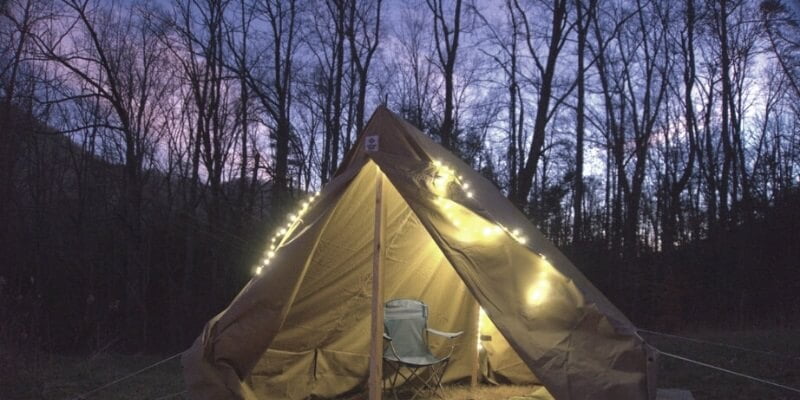
Good idea: A tarp protects the tent from UV radiation and ensures pleasant temperatures during the day.
10. Be gentle on your zippers
The zipper caught a piece of tent fabric. Do not use force. Hold the zipper tape with one hand and carefully pull the slider. Rock the slider to the left and right until the jammed fabric loosens.
If the zipper splits, gently pull it back and forth. Most of the time, the teeth close again. If it doesn’t help, use a pair of pliers to gently pinch the sides of the slider together a little to hold the slider in place.
11. Use toothbrush and silicone spray on the zipper
Dirt particles in the zipper increase its wear and tear. Therefore, regularly clean the zipper of sand and dirt. That works great with a toothbrush. Then care for the zipper with silicone spray or the wax of a candle. This keeps the zipper running smoothly and significantly increases its service life.
A nice side effect of the silicone spray is the zipper becomes more waterproof.
12. Take off your shoes in the awning or outside
Dirt, sand, and pebbles will fall off your shoes as they dry. Then they lurk on the tent floor and wait for someone to step on them. The small intruders sand the coating of your floor or prick fine holes in it. For additional protection, you can put a picnic blanket or tent carpet on your floor.
13. Pack food in a tight container
Pack your food in a food container or box. Otherwise, it can happen that a cute little animal gnaws its way through your tent in search of its next meal. Open foods also attract ants. You will be surprised how many hungry ants live near your tent.
14. Stretch a tarp over your tent
A tarp can protect your beloved tent from UV radiation. A robust and sun-proof SilNylon tarp is best. This second shelter extends the life of your tent and has other advantages for you. For example, during the day it is significantly cooler in the tent, and at night a little bit warmer.
Also, the rain does not drum quite as loudly in your accommodation.
15. Never leave your dog unattended in the tent
The sun heats up the tent very quickly. Also, the noises from outside are much more exciting than in a silent, immovable tent. If your trusty companion decides that it is time to accompany you outside, you can severely damage the sensitive tent material with his claws.
Tent Care Tips When Dismantling
You can also take care of your tent when it is dismantled.
16. Shake out your tent
You certainly don’t want to wrap any sharp stones or pine needles in your tent when packing – this can damage the fabric. Therefore, remove rubbish and dirt from your tent before packing it up. The best way to do this is to take the inner tent out of your tent, turn it inside out, and shake it out.
It’s particularly easy to shake out small or free-standing tents – the poles keep the tent open while you throw out the dirt. Shaking it out is better than sweeping it out! Sand and dirt have no chance of chafing the tent floor.
17. Always push out tent poles, do not pull
Rods with a rubber band can be pulled out of the rod channels quickly and easily. But if a rod segment gets stuck in the process – and this often happens – the rubber band in the rod can tear. Then you need to fix the tent pole.
- Tip: slide the poles out of the channels. This takes a few seconds longer but saves you from having to repair the bar later.
18. Fold the bars in half first
This distributes the tension evenly across the rubber band. Fold the left and right halves of the bar in the middle again and repeat this until the bar is completely folded.
19. Dry the tent well before packing it up
Every tent gets damp during use even in sunny weather, often the soil it stands on gives off some moisture. And at night, condensation forms in the outer tent.
Moisture is harmful to your tent. Mold, mold stains, and hydrolysis of the coating quickly ruin the fabric. Therefore, dry your tent as well as possible before packing it up. You can carefully hang it over a branch or on a bush. If you need to pack the tent damp, dry it at home as soon as possible.
- Tip: A new impregnation improves protection against mold and hydrolysis.
20. Roll up the tent
Don’t just stuff the tent in the pannier. The stuffing takes a lot of strength and is exhausting for the tent fabric and its coating. A properly rolled-up tent also has fewer wrinkles the next time it is set up.
21. Stow pegs and poles in bags
Pegs and poles that are loose in the tent pack sack can easily damage the tent during transport. So always stow your pegs and poles in the supplied packing bags. If necessary, a textile carrier bag from the supermarket will do the job.
Tent Care Tips At Home
The ideal storage place for your tent is dry, cool, and free of curious rodents. With these tips, you will keep your tent in excellent condition until your next tour.
22. Clean your tent from mud and dirt
Clear your tent of most of the dirt before you store it. A clean, well-maintained tent does not provide a breeding ground for mold and vermin and usually smells better when you take it out of the packsack for the next tour.
23. Dry your tent 100% before storing
The most important tent care tip: dry your tent really well. To do this, simply set it up in the garden on a sunny day and open the entrances.
If it rains, hang it on a clothesline in the garage or basement. This is very important! Over time, mold will grow on damp fabrics. The tent gets dark spots and can smell really bad. Cotton is particularly prone to mold.
Tents with a PU coating are even worse – moisture slowly decomposes the coating through hydrolysis. Then the protective layer will peel off and you will have to replace the tent. So when you pack your tent, it should really be completely dry.
24. Store the tent in a cool and dry place
Good places are temperature-controlled living areas and dry cellars. Bad places are not insulated, with hot attics and damp barns. In that case, the tent packsack is great for transporting the tent nicely and compactly. It is not ideal for long-term storage: the tent wants to relax and breathe. A mesh bag or a pillowcase are better choices. The advantage is that mold has no chance. This is especially important for you if you have a cotton tent.
This is How You Can Clean Your Tent
When you pack the tent, it should be reasonably clean. In order to optimally care for your tent, gently remove dust, mud, sand, bird droppings, and tree sap after your camping trip.
25. Avoid washing machines and dryers
Never put your tent in a washer or dryer. Washing powder, friction, and heat destroy the coating on the tent fabric. And the zips can damage the sensitive tent fabric when it is thrown washing machine.
26. Be very gentle when you cleanse
Clay, salt, bird droppings, sand, and tree resin attack the tent fabric. So dirt has to get off the tent.
Caution: Your tent has a sensitive waterproof coating. You don’t want to scrub them away! Gently clean dirty areas with a soft sponge or brush and plenty of water.
- Pro tip: A microfiber washing glove for cars is ideal for cleaning tents. It not only protects the sensitive car paint but also your tent coating.
27. Use suitable cleaning agents

Nikwax Softshell Cleaning & Waterproofing
Universal cleaners, stain removers, pre-wash detergents, and especially scouring milk are far too aggressive. This can cause the tent to leak. Perfumed soaps attract insects and rodents.
The best way to maintain your tent is with gentle means: unscented soap and lukewarm water are ideal. If you want an even better cleaning effect, you can use a special tent cleaning agent. So you are on the safe side.
However, the tent should be re-impregnated after every thorough cleaning. Then raindrops and mud roll off the surface like a brand-new tent and are not absorbed by the fabric.
Make Your Tent Waterproof
The tent is dripping – do I have to buy a new tent now? No, with the right care products you can make your tent waterproof again.
28. Check your tent with the Watering Can
Would you like to know whether your tent is still waterproof?
Grab the next watering can or the garden hose and let a good portion of water rain on the completely erected outer tent! If you can see drops of water or even small puddles inside the tent, you have to act.
29. Reseal leaky seams
Most tents have a polyurethane coating and are sealed waterproof with seam tape during manufacture. However, the ravages of time are gnawing: the adhesive tape can peel off. Carefully remove any loose spots.
Because the tape will leave residue on the inside of the seam, apply a thin layer of Gear Aid’s clear seam sealer to the outside of the seam. After a drying time of 24 hours, your tent will be perfectly waterproof again.
30. Repair small holes and cracks
You can also easily repair small holes and short cracks with a maximum length of 3 centimeters with the transparent seam sealer.
31. Renew the impregnation
Did the watering can test run off the water in small drops or did a film of water form on your tent? A film of water means that the impregnation that protects your tent from the elements of nature is no longer in order. You have to renew them so that your tent stays beautiful for a long time.
32. Get the right tools for your tent
Most tents are made of polyester and have a polyurethane coating. However, some high-quality models are made of silicone-coated nylon. Silicone is incredibly smooth. Very few adhesives stick really well to silicone.
If your tent has a silicone coating, you can repair the seams with silicone-based seam sealers. You can also stick on patches with the silicone seam sealer.
Tent Care Tools and Equipment List
We recommend the following items to extend the life of your tent.
- Tent pad
- Seam sealer
- Tent pavement
- Tent cleaner
- Wash mitt
- Impregnation spray
- Reserve tent pegs
- Soft-bristle brush or sponge
- Mild soap or specialized tent cleaner
- Non-abrasive cloth or sponge
- Mallet or hammer
- Tent pole shock cord
- Tent heater (Applicable and only for cold-weather camping)
- Storage bags for components
- Zippers lubricant
If you follow these simple tips, your tent is sure to last longer. So use these tips to accompany yourself on many wonderful camping trips and create lots of memories with your tent.
Thank you for your interest in my guide. Do you have any questions or suggestions about the contribution? How do you take care of your tent? Just write me a short message in the comment section.

